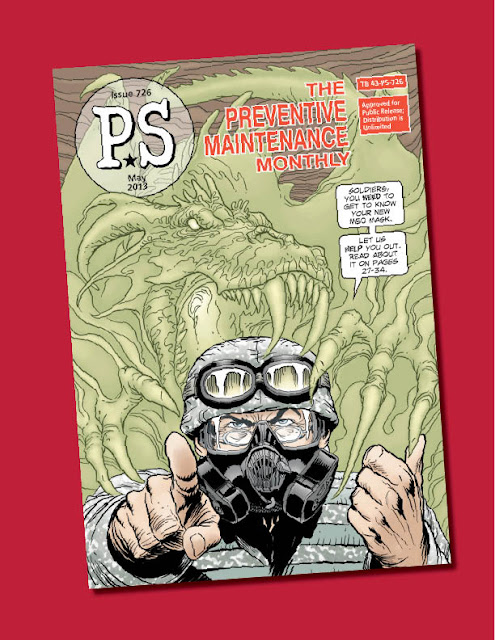A change of command ceremony June 20
at Redstone Arsenal (Huntsville, Alabama) introduced Colonel Charles “Chuck” B.
Salvo as the new leader of the U.S. Army Logistics Support Activity (LOGSA),
which is under the U.S. Army Materiel Command (AMC). The PS Magazine program is an
element of LOGSA.
In the image below, Major General
Gustave F. Perna, right, AMC’s Deputy Chief of Staff (G-3/4) passes the guidon
to Colonel Salvo at AMC Headquarters.
 Colonel Salvo succeeds Colonel Robert P. “Pat” Sullivan, who
was the official host for the PS Magazine Sixtieth
Anniversary Celebration in June of 2011. To see a video clip of his remarks on
that occasion, click here.
Colonel Salvo succeeds Colonel Robert P. “Pat” Sullivan, who
was the official host for the PS Magazine Sixtieth
Anniversary Celebration in June of 2011. To see a video clip of his remarks on
that occasion, click here.  General Dennis L. Via commands AMC. To see a video clip of his
remarks at the PS Sixtieth Anniversary Celebration, click here.
General Dennis L. Via commands AMC. To see a video clip of his
remarks at the PS Sixtieth Anniversary Celebration, click here. At that time, he wore three stars and was Deputy Commanding General of AMC. Since then, he received his fourth star and was advanced to the top spot at AMC.

Colonel Salvo is a native of Niagara Falls, New York, and graduated from the State University of New York with a Bachelor of Science in biology, and was commissioned Infantry in 1986. After completing the infantry officer basic course and ranger school, he was assigned to the 2nd Battalion (ABN) 187th Infantry battalion, Fort Kobbe, Panama, where he served as a rifle platoon leader, company executive officer, and earned the Expert Infantryman Badge, Jungle Expert Badge, and graduated from jumpmaster school. He was selected for promotion to captain and re-branched Quartermaster in 1989 and was assigned to the 407th S&T Battalion, 82d Airborne Division where he deployed for Operation Desert Shield/Storm and served as a company commander and battalion S3. At Fort Lee, Virginia, he served as aide-de-camp for the CG Combined Arms Support Command and taught advanced aerial delivery school. In the 10th Mountain Division, he served as DISCOM S3, and Support Operations Officer, and later Executive Officer, 210th FSB.
At Fort Leavenworth, Kansas, he earned a Master’s Degree in
acquisition and procurement management, graduated from the Combined Arms Staff
School and was later assigned to Joint Forces Command. After graduating from
the Joint and Combined Warfighting School in Norfolk, VA, he was selected for a command slot in the 3rd Infantry Division where he led the 203rd
Forward Support Battalion/Brigade Support Battalion for 36 months and led the
organization through two Operation Iraqi Freedom (OIF) tours, to include OIF I,
two Combat Training Center rotations, and transformed the organization from a
forward support battalion to a brigade support battalion consisting of five
companies and over 1,200 soldiers.
After graduating from the Army War
College, he was assigned as Director, force integration and joint concepts,
Army G4, the Pentagon. He was selected to command of the Army and Air Force
Exchange, for OIF/OEF and Europe, a $6 billion/year in sales organization, for
36 months, and led the organization through the drawdown in Iraq, the surge in
Afghanistan, and transformation in Europe. Prior to assuming command of LOGSA,
he served as Executive Officer to the Executive Deputy to the Commanding
General, AMC.
Colonel Salvo’s awards and decorations include Legion of Merit,
Bronze Star Medal with two Oak Leaf Clusters, Defense Meritorious Service
Medal, Meritorious Service Medal with four Oak Leaf Clusters, Ranger Tab,
Combat Action Badge, Expert Infantryman Badge, Rigger Badge, Master Parachutist
Badge, Jungle Expert Badge, Panamanian and Australian Airborne wings, the Army
Staff Badge, and the Army physical fitness badge (current).
He is married to Sondra and has two children: Sam (16) and
Hollie (19).
• • •
Here’s an “OOPS!”
With some of my “Heads Up” text regarding an upcoming blogpost about
Master Sergeant Bull Dozer, I left a misperception with a few readers that the
Engineers’ icon from the PS past was returning to the magazine’s
pages for an extended gig. Not so! It was just a cameo appearance. You’ll see
all the details in my next post.
—Fitz
UPCOMING
POSTINGS:
¶
Master Sergeant Bull Dozer Revisited
¶ A
View of PS
at the Four-Star Level
¶ Best
of PS by
Perspective Instructional Communications
¶ A
Covey of Connies—World War II to Today













